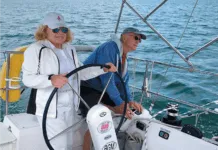Excerpted from The Weekend Navigator, Second Edition, Bob Sweet
Double-Checking Your Navigation
Quick Comparisons with the GPS
A quick comparison of visual bearings with their corresponding GPS bearings isn’t precise, but it will give you confidence in what your GPS is telling you. This very simple technique will encourage you to make regular checks.
Your GPS Map Screen displays nearby landmarks and buoys whose waypoints you have programmed into your unit. You may need to zoom out to bring them into the field of view, and you need to get yourself oriented. Generally you will be using a North-Up display on the GPS, and your direction of travel will be indicated by the orientation of the boat symbol (usually a sharp triangle). If you are sighting quick relative bearings, such as a beam bearing, simply look to see whether the chosen landmark appears to be abeam of the symbol on the screen. If the GPS has truly failed, it is unlikely that the two will agree; if the two agree, it is unlikely that the GPS has failed. If you are still uncertain, take some more precise bearings for comparison.
If youve sighted a bearing across the compass, you need a numeric GPS bearing to compare it with. Using the cursor key on a newer model GPS, scroll to that buoy or landmark on the Map Screen; when it is highlighted, the GPS will show its bearing in a data window. Simply compare the GPS reported bearing with your visual observation. Assuming you set up your GPS to magnetic direction, no conversion is required. If the GPS bearing and your observation match, at least within about three to five degrees, your GPS appears to be working properly.
If any of your quick observations do not match, its a time for a more detailed approach.
For more advice on navigating with your GPS and other electronics, purchase The Weekend Navigator from Practical Sailor.




































